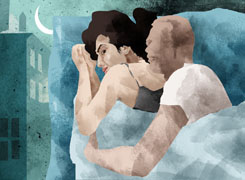Can I Improve My Monthly SIP Investments of Rs. 12,500?
Ramalingam Kalirajan |8924 Answers |Ask -Follow
Mutual Funds, Financial Planning Expert - Answered on Aug 14, 2024
He has an MBA in finance from the University of Madras and is a certified financial planner.
He is the director and chief financial planner at Holistic Investment, a Chennai-based firm that offers financial planning and wealth management advice.... more

Hi Sir Kindly suggest for any modification if required as per my current investments in SIP. Currently I am investing 2.5k in each funds in below mentioned SIP. 1. Axis focused fund regular growth 2.Invesco Small cap Regular 3.Canara Robeco Small cap Regular 4.Mirae asset large cap Regular growth 5.Nippon India index fund Nifty 5. Parat parikh flexi cap fund
Fund Categorization and Allocation
Large-Cap Funds:
Large-cap funds offer stability. They focus on established companies with strong market presence.
Small-Cap Funds:
Small-cap funds provide growth potential but carry higher risk. These funds invest in emerging companies that may not be as stable.
Focused and Flexi-Cap Funds:
Focused funds invest in a limited number of stocks. This approach allows concentrated growth but with increased risk.
Flexi-cap funds provide flexibility by investing across market caps. This diversification can reduce risk.
Index Fund Consideration
You've included an index fund in your portfolio. While index funds have low management fees, they also lack the potential for outperforming the market. Actively managed funds, on the other hand, can provide higher returns, especially in volatile markets. A Certified Financial Planner can help identify funds that might outperform the index, offering better growth opportunities.
Benefits of Regular Funds Over Direct Funds
Regular funds come with the advantage of professional guidance. A Certified Financial Planner can help tailor your investments to your goals. Direct funds might save on commissions, but without expert advice, the risk of underperformance increases. The expertise of a CFP ensures your portfolio is aligned with your financial objectives.
Diversification and Risk Management
Your current portfolio is diversified across various fund categories, which helps spread risk. However, too much overlap in fund types, like small-cap funds, can increase risk unnecessarily. It's crucial to maintain a balanced allocation that aligns with your risk tolerance and financial goals.
Investment Horizon and Goals
Understanding your investment horizon is key. If you're investing for long-term goals like retirement, a mix of equity-oriented funds is suitable. For medium-term goals, consider reducing exposure to high-risk funds and adding more balanced or debt funds.
Final Insights
Review Overlap: Evaluate the overlap in your small-cap funds. Diversify across other categories for better balance.
Reconsider Index Fund: Actively managed funds may provide better growth potential. A CFP can guide you in selecting suitable alternatives.
Seek Professional Guidance: The benefits of regular funds, with expert advice, outweigh the savings from direct funds. A Certified Financial Planner can help maximize returns and manage risk.
Adjust for Goals: Align your portfolio with your financial goals. Adjust your fund allocation based on your investment horizon and risk tolerance.
Best Regards,
K. Ramalingam, MBA, CFP,
Chief Financial Planner,
www.holisticinvestment.in
You may like to see similar questions and answers below
Vivek Lala | Answer |Ask -Follow
Tax, MF Expert - Answered on May 24, 2023
Ramalingam Kalirajan |8924 Answers |Ask -Follow
Mutual Funds, Financial Planning Expert - Answered on May 01, 2024
Ramalingam Kalirajan |8924 Answers |Ask -Follow
Mutual Funds, Financial Planning Expert - Answered on May 17, 2024
Ramalingam Kalirajan |8924 Answers |Ask -Follow
Mutual Funds, Financial Planning Expert - Answered on May 25, 2024
Ramalingam Kalirajan |8924 Answers |Ask -Follow
Mutual Funds, Financial Planning Expert - Answered on Jun 16, 2025
Ravi Mittal |601 Answers |Ask -Follow
Dating, Relationships Expert - Answered on Jun 16, 2025
Radheshyam Zanwar |3365 Answers |Ask -Follow
MHT-CET, IIT-JEE, NEET-UG Expert - Answered on Jun 16, 2025
Radheshyam Zanwar |3365 Answers |Ask -Follow
MHT-CET, IIT-JEE, NEET-UG Expert - Answered on Jun 16, 2025
Radheshyam Zanwar |3365 Answers |Ask -Follow
MHT-CET, IIT-JEE, NEET-UG Expert - Answered on Jun 16, 2025
Radheshyam Zanwar |3365 Answers |Ask -Follow
MHT-CET, IIT-JEE, NEET-UG Expert - Answered on Jun 16, 2025
Radheshyam Zanwar |3365 Answers |Ask -Follow
MHT-CET, IIT-JEE, NEET-UG Expert - Answered on Jun 16, 2025
Radheshyam Zanwar |3365 Answers |Ask -Follow
MHT-CET, IIT-JEE, NEET-UG Expert - Answered on Jun 16, 2025
Radheshyam Zanwar |3365 Answers |Ask -Follow
MHT-CET, IIT-JEE, NEET-UG Expert - Answered on Jun 16, 2025
Nayagam P P |6421 Answers |Ask -Follow
Career Counsellor - Answered on Jun 16, 2025

























